
| Genus List | Species List |
This key is based in part on those from Brown (1958) and Lattke (1995).
10a. Propodeum armed with a pair of long, slender spines, normally at least as long as the distance between the inner sides of their bases: bispinosa
10b. Propodeum unarmed, or with a much smaller pair of teeth: 20

20a. AT4 strongly vaulted and much inflated; sculpture never costate: 30
20b. AT4 less strongly vaulted; sculpture costate or not: 50
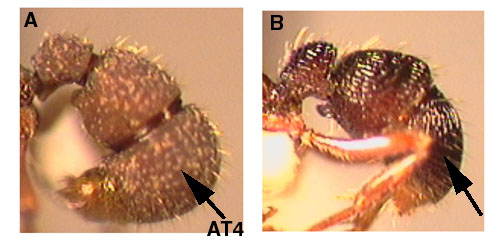
30a. AT4 uniformly granular and smooth; head width less than 1.0mm, length of mesosoma (WL) less than 1.6mm: minuta
30b. AT4 with distinct, evenly spaced foveae; size larger, head width greater than 1.0mm, WL greater than 1.6mm: simulans
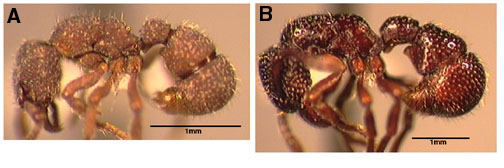
50a. Pronotum separated from remainder of mesosoma by a very distinct suture (pronotal suture), completely breaking the sculpture; propodeal suture present or absent (determining whether a suture is the pronotal or propodeal may be difficult; look for the presence of the other one as a faint to strongly impressed line): 60
50b. Pronotal suture absent across the dorsum, or indicated by an impressed line that does not break the sculpture: 200
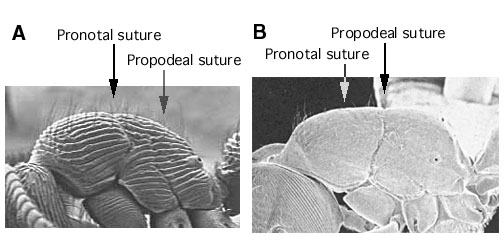
60a. Anteroventral process of petiole square-cut, with sharp posterior angle: 70
60b. Anteroventral process of petiole not square-cut, either a regularly tapering anterior tooth, or broad lobe with evenly rounded posterior margin: 140
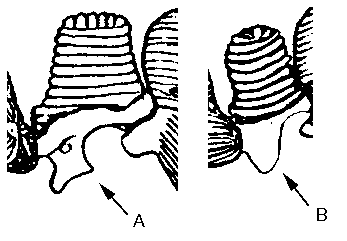
70a. Propodeal suture distinctly impressed, breaking sculpture, equal to promesonotal suture: bisulca
70b. Propodeal suture not impressed, not breaking sculpture, much weaker than promesonotal suture: 80
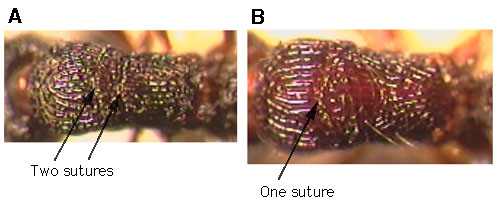
80a. Mesonotum and dorsal face of propodeum forming even convexity; scapes relatively short, surpassing margin of vertex by less than length of first funicular segment: 90
80b. Mesonotum and dorsal face of propodeum forming concavity (in other words, dorsal face of propodeum somewhat differentiated from mesonotum, more horizontal); scapes relatively longer, surpassing margin of vertex by more than length of first funicular segment: wheeleri
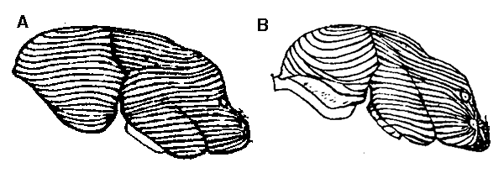
90a. Petiole relatively symmetrical in side view, without strongly tilted posterior face: strigata
90b. Petiole strongly asymmetrical, tilted posteriorly, the posterodorsal angle sharply rounded and slightly overhanging the posterior face: JTL-006
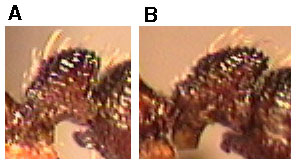
140a. Petiolar node erect, in side view the posterodorsal angle not very much more sharply rounded than anterodorsal angle, and not overhanging posterior face: curtula
140b. Petiolar node tilted posteriad in side view, the postero-dorsal angle sharply rounded and overhanging the posterior face: 170

170a. Scapes relatively short, surpassing margin of vertex by less than length of first funicular segment, SI 110; relatively smaller, WL 1.5mm: JTL-005
170b. Scapes relatively longer, surpassing margin of vertex by more than length of first funicular segment, SI 115; relatively larger, WL 1.9mm: porcata

200a. When head is seen in perfect full-face view, and the antennal scapes are laid back as straight as possible from their insertions, they either fail to reach or just barely reach, but do not distinctly surpass, the margin of vertex nearest to where they fall: 210
200b. In same view, scapes do surpass margin of vertex: 320

210a. Dorsal surfaces of mandibles distinctly striate over the basal fourth or more of their length: 220
210b. Dorsal surfaces of mandibles smooth and shining to the base, though sometimes with scattered punctures: 230

220a. Larger species, head width across eyes greater than 1.2mm; mandibular striation extending from insertions to apices: haenschi
220b. Smaller species, head width across eyes less than 1.0mm; greater than apical half of mandibles smooth and shining: hartmani

230a. Dorsal face of propodeum predominantly or wholly transversely striate, although the anteriormost portion may sometimes bear sharply diverging oblique striation: 240
230b. Dorsal face of propodeum predominantly longitudinally costulate or striate, continuing the longitudinal promesonotal sculpture straight back to at least the propodeal midlength,and usually beyond 250
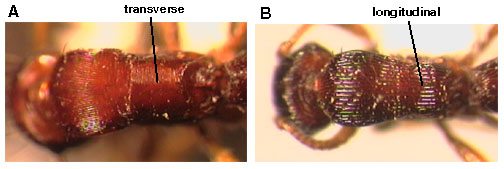
240a. Large, long-headed species, HL greater than 1.7mm; when head is seen in perfect full-face view, vertex margin evenly convex; blunt but distinct vestiges of paired teeth on the propodeum: alfaroi
240b. Smaller, more short-headed species, HL less than 1.5mm; when head is seen in perfect full-face view, vertex margin straight or feebly concave in the middle; propodeum absolutely unarmed: annulata

250a. Anterior margin of narrow anterior apron of clypeus straight to distinctly concave in the middle, terminating laterally in rounded corners: 260
250b. Anterior margin of anterior apron of clypeus usually straight, terminating laterally in sharply rectangular corners (HW greater than 0.73mm, petiolar node longitudinally costulate): regularis

260a. Anteroventral petiolar process more or less tapering anteriorly, lacking posterior lobe or square-cut corner, and lacking distinct fenestra; HW usually greater than 0.9mm: 300
260b. Anteroventral petiolar process with posterior lobe or square-cut corner, and with distinct fenestra; HW usually less than 0.8mm: interrupta complex
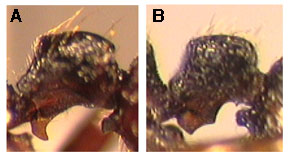
300a. Compound eye of worker large, its greatest diameter greater than the maximum width of antennal scape; eye diameter/HW = 0.26; AT4 smooth and shining: mordax
300b. Compound eye of worker small, its greatest diameter subequal to the maximum width of antennal scape; eye diameter/HW = 0.12; AT4 longitudinally striate, at least anteriorly: stellae
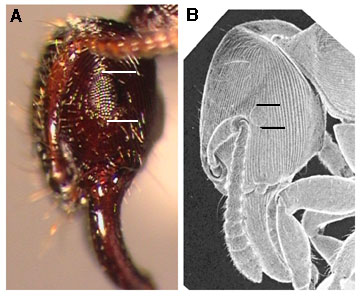
320a. Mandibles smoothly curving such that basal and apical margins form a continuous convexity: 340
320b. Mandibles triangular to subfalcate, with basal margin flat or concave: 360
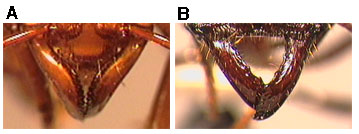
340a. Large, light orange species; HW without eyes greater than 2.0mm; sculpture finely striate: concinna
340b. Smaller species; HW less than 2.0mm: 350

350a. Head in back of antennal insertions black or nearly so; mandibles straw yellow, contrasting sharply with black of cranium; mesosoma, node and gaster varying from black to yellowish-red; costulae of posterior face of propodeum longitudinal; eyes relatively larger and more elongate (eye length = 0.36, eye width = 0.23, n=2 workers): sulcata
350b. Head yellowish to brown in color; mandibles dull yellow to brownish, usually lighter than cranial color, but not markedly contrasting with it; head and rest of body nearly concolorous; costulae often transverse across posterior face of propodeum; eyes relatively smaller and less elongate (eye length = 0.25, eye width = 0.18, n=1 worker): tornata

360a. Large, dark red brown species; HW greater than 2.0mm; mandibles subfalcate, almost linear: banksi
360b. Smaller species; HW less than 1.5mm; mandibles triangular to subfalcate, but not nearly linear: 370

370a. Mandibles approaching a subfalcate condition; basal margin erose, with a distinct concave notch near junction with apical margin; propodeum completely unarmed: volcano
370b. Mandibles distinctly triangular, basal margin flat; propodeum with small peg-like teeth: 380
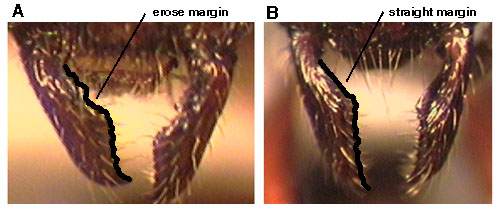
380a. Mandibles relatively more triangular; pronotal dorsum with longitudinal costulae that extend all the way to the anterior margin, only occasionally with one or two obscure transverse costulae at the junction of pronotum and occiput; posterior lobe of subpetiolar process low, much smaller than large anterior tooth: triangularis
380b. Mandibles relatively more linear; anterior pronotum covered by a broad band of transversely arching costulae; posterior lobe of subpetiolar process well developed, square-cut to acute, and subequal in size to anterior tooth: mecotyle

Literature Cited
Brown, W. L., Jr. 1958. Contributions toward a reclassification of the Formicidae. II. Tribe Ectatommini (Hymenoptera). Bulletin of the Museum of Comparative Zoology 118:175-362.
Lattke, J. E. 1995. Revision of the ant genus Gnamptogenys in the New World (Hymenoptera: Formicidae). Journal of Hymenoptera Research 4:137-193.
Page author:
John T. Longino, The Evergreen State College, Olympia WA 98505 USA.longinoj@evergreen.edu